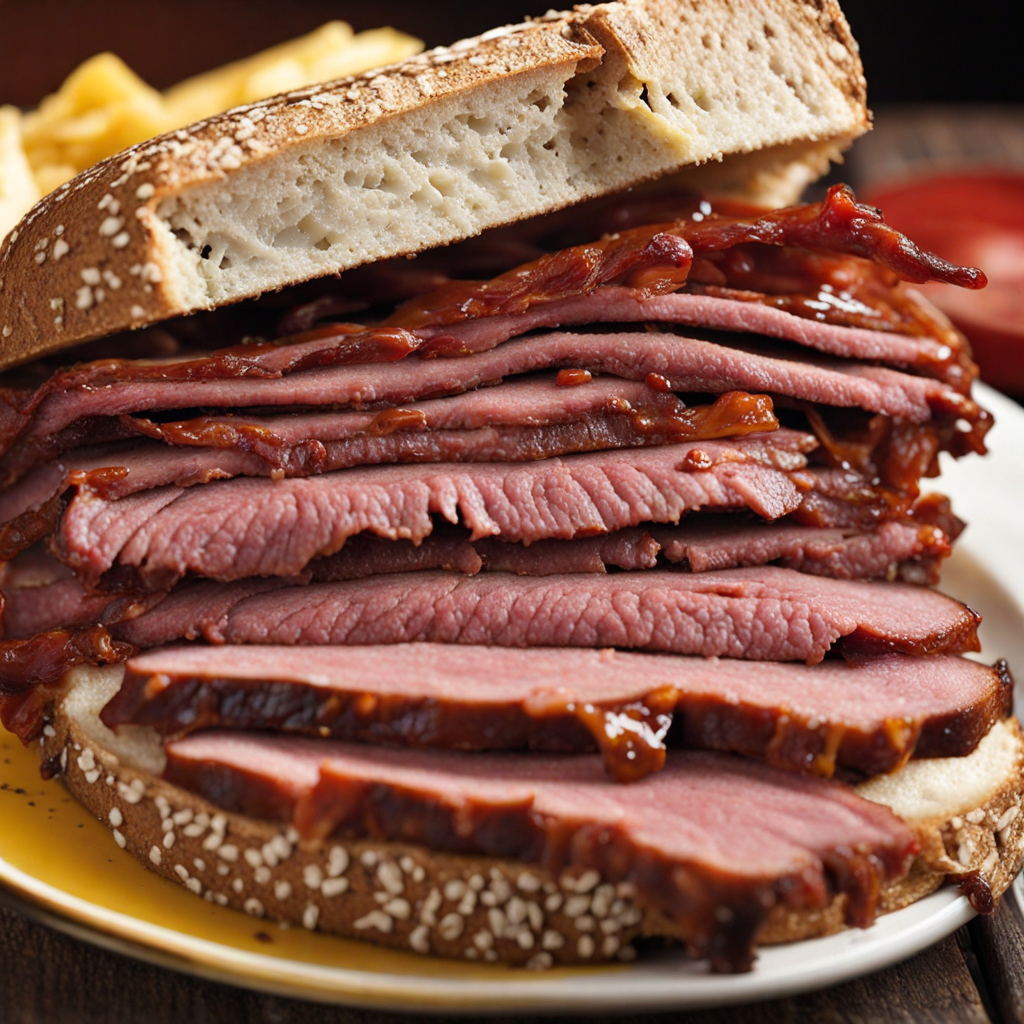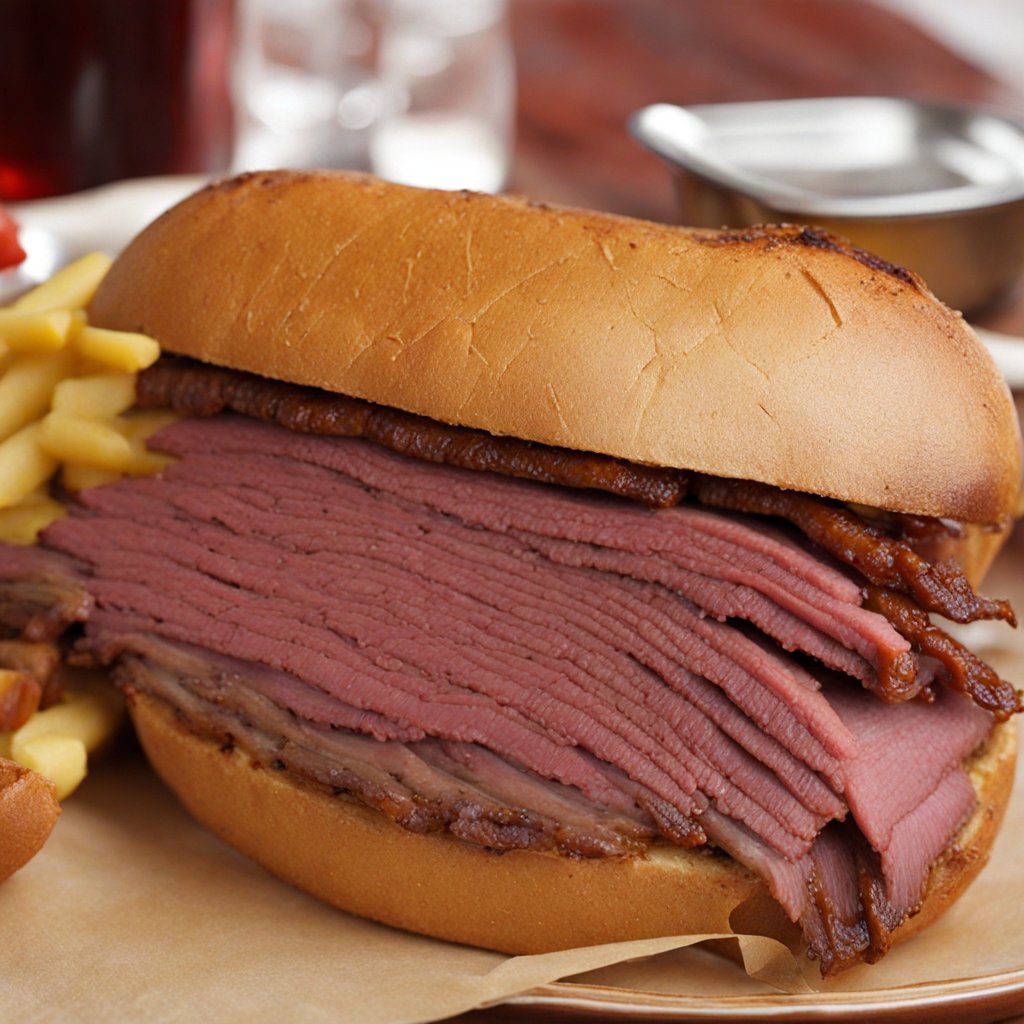Montreal Smoked Meat
Montreal Smoked Meat is a culinary gem that hails from the vibrant city of Montreal, Canada. This delicacy is a type of kosher-style deli meat, made from beef brisket that is cured and smoked to perfection. The process begins with a generous rub of spices, typically including black pepper, coriander, and garlic, which infuse the meat with a robust flavor. After curing, the brisket is slowly smoked, resulting in a tender, juicy texture that melts in your mouth. The combination of its smoky aroma and the savory spices creates a unique taste that is both comforting and invigorating, making it a must-try for any food enthusiast. Traditionally, Montreal Smoked Meat is served on rye bread, often accompanied by mustard, and is typically stacked high in a sandwich that showcases the meat's rich, smoky flavor. The contrast of the crunchy bread and the tender meat elevates the experience, while a side of pickles adds a refreshing zest. Many locals and visitors alike enjoy it with a side of coleslaw or French fries, making for a satisfying meal that captures the essence of Montreal's diverse culinary scene. The sandwich is often paired with a classic soda or a local beer, enhancing the flavors and making it a delightful indulgence. In addition to its delicious taste, Montreal Smoked Meat carries a cultural significance that reflects the city's Jewish heritage. It has become a beloved staple in delis throughout Montreal and beyond, often drawing visitors who are eager to experience this iconic dish. Whether enjoyed in a bustling deli or at a casual eatery, Montreal Smoked Meat offers a taste of history and tradition, inviting food lovers to savor its rich flavors and appreciate the craftsmanship involved in its preparation.
How It Became This Dish
Viande Fumée de Montréal: A Culinary Journey Through Time Origins Viande fumée de Montréal, or Montreal smoked meat, is a quintessential delicacy that has become synonymous with Canadian cuisine, particularly in the vibrant city of Montreal. Its origins can be traced back to the Jewish immigrants from Eastern Europe, who arrived in Canada in the late 19th and early 20th centuries. These immigrants brought with them a rich tapestry of culinary traditions, including methods of preserving meat that were deeply embedded in their cultural practices. The technique of smoking meat was not new; it had been employed for centuries as a means of preservation before the advent of refrigeration. However, the method evolved within the Jewish community, where it was adapted to create a unique product that would eventually become a staple of Montreal's culinary landscape. The early versions of smoked meat were influenced by the Eastern European pastrami, which is made from beef brisket and seasoned with a blend of spices, including black pepper, garlic, and coriander. Cultural Significance As Montreal developed into a multicultural hub, the Jewish community played a pivotal role in shaping the city’s food culture. By the early 20th century, delicatessens began to sprout up in the neighborhoods populated by Jewish immigrants, particularly in areas like Mile End and St. Urbain Street. These establishments served as social and cultural centers where people gathered to share food, stories, and traditions. Montreal smoked meat quickly became a symbol of Jewish culinary heritage, representing not just a delicious meal but also a sense of identity and belonging. The cultural significance of viande fumée de Montréal extends beyond its flavor. The dish embodies the resilience and adaptability of immigrant communities. As Jewish immigrants faced the challenges of assimilation and cultural preservation, Montreal smoked meat became a way to maintain their traditions while also contributing to the broader Canadian culinary tapestry. It is a dish that tells the story of survival, community, and the blending of cultures. Development Over Time The evolution of viande fumée de Montréal is marked by a series of innovations and adaptations that have shaped its identity. The traditional method of preparation involves curing the beef brisket with a mixture of salt, sugar, and spices. After curing for several weeks, the meat is then smoked and steamed, resulting in a tender, flavorful product that is sliced thin and served on rye bread, typically accompanied by mustard and pickles. In the early 20th century, establishments like Schwartz’s Deli, founded in 1928 by Reuben Schwartz, popularized the dish and established it as a culinary icon. Schwartz’s is often credited with perfecting the art of Montreal smoked meat, and it became a pilgrimage site for food lovers. The deli’s success contributed to the proliferation of other establishments offering their own takes on the dish, leading to a friendly rivalry among delis in the city. As the years went by, the popularity of viande fumée de Montréal spread beyond Montreal, reaching other parts of Canada and the United States. It garnered attention from food enthusiasts and critics alike, earning accolades as one of the best sandwiches in the world. This recognition highlighted the dish’s unique flavor profile and the craftsmanship involved in its preparation. In the 1980s and 1990s, the rise of food television and the gourmet food movement further propelled the popularity of Montreal smoked meat. Chefs and food bloggers began to showcase the dish, often experimenting with modern twists while still honoring its traditional roots. The dish became a staple at food festivals and was featured in various culinary publications, elevating its status in the gastronomic world. Contemporary Scene Today, viande fumée de Montréal continues to thrive in Montreal and beyond. Modern delis and restaurants have embraced the dish, offering innovative interpretations alongside the classic preparations. Some establishments have even expanded their menus to include smoked meat poutine, sandwiches topped with gourmet ingredients, and even smoked meat pizza, showcasing the versatility of this beloved ingredient. Moreover, the cultural significance of viande fumée de Montréal has been recognized at a national level. In 2016, the dish was designated a "Cultural Heritage" food by the Canadian government, acknowledging its importance in the country’s culinary landscape. This recognition has helped to preserve traditional methods of preparation while also promoting the dish to new audiences. The rise of food tourism has also played a role in the continued popularity of viande fumée de Montréal. Visitors flock to the city to experience the rich culinary heritage, and Montreal smoked meat is often at the top of their must-try lists. Food tours that highlight local delicacies frequently include stops at iconic delis, where tourists can savor the authentic flavors while learning about the history and cultural significance of the dish. Conclusion Viande fumée de Montréal is more than just a sandwich; it is a testament to the resilience and creativity of the immigrant communities that helped shape it. From its humble beginnings as a method of preserving meat to its status as a beloved Canadian culinary icon, the dish encapsulates the spirit of Montreal—a city defined by its diversity, rich history, and a profound love for food. As we continue to enjoy this delectable delicacy, we also honor the traditions and stories that it carries. Whether served in a classic deli or reimagined in contemporary cuisine, Montreal smoked meat remains a profound symbol of cultural heritage, community, and the enduring power of food to bring people together.
You may like
Discover local flavors from Canada







